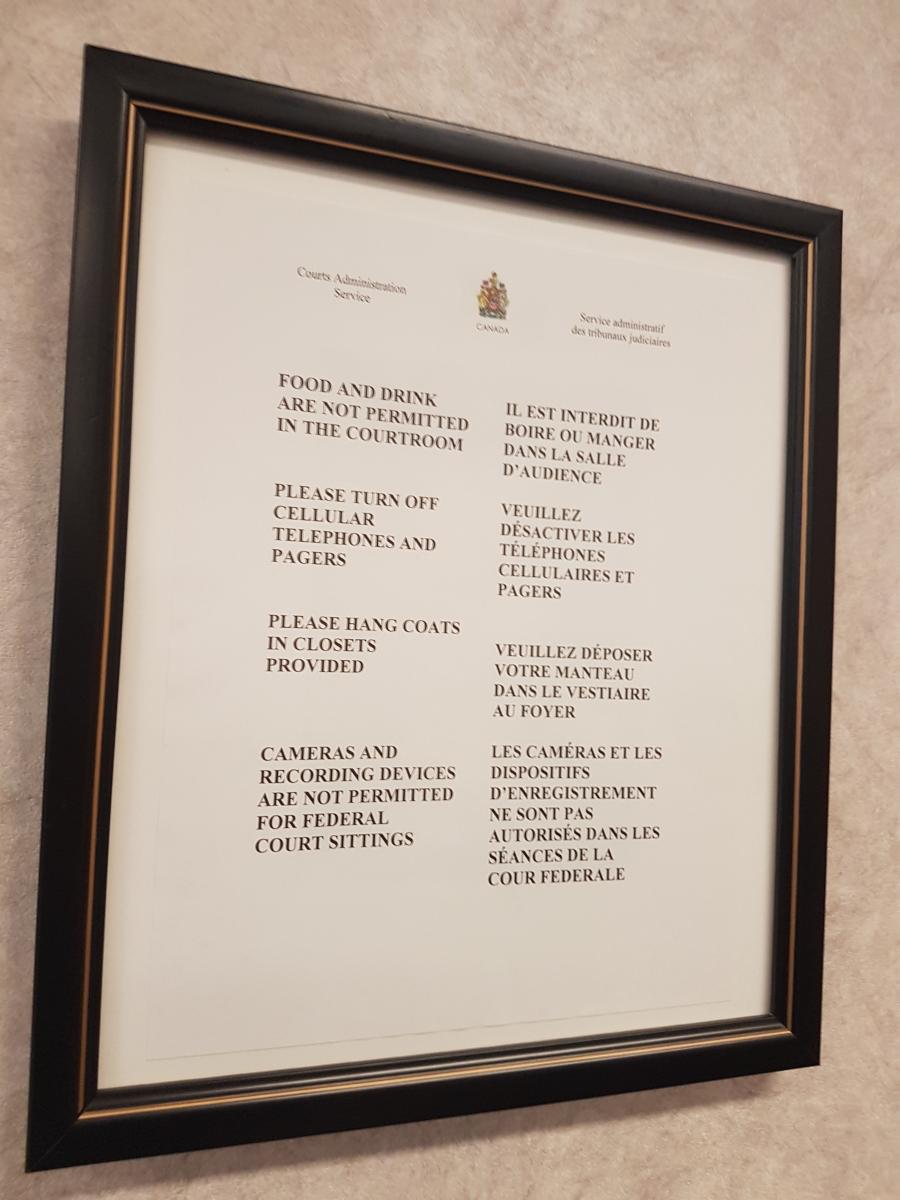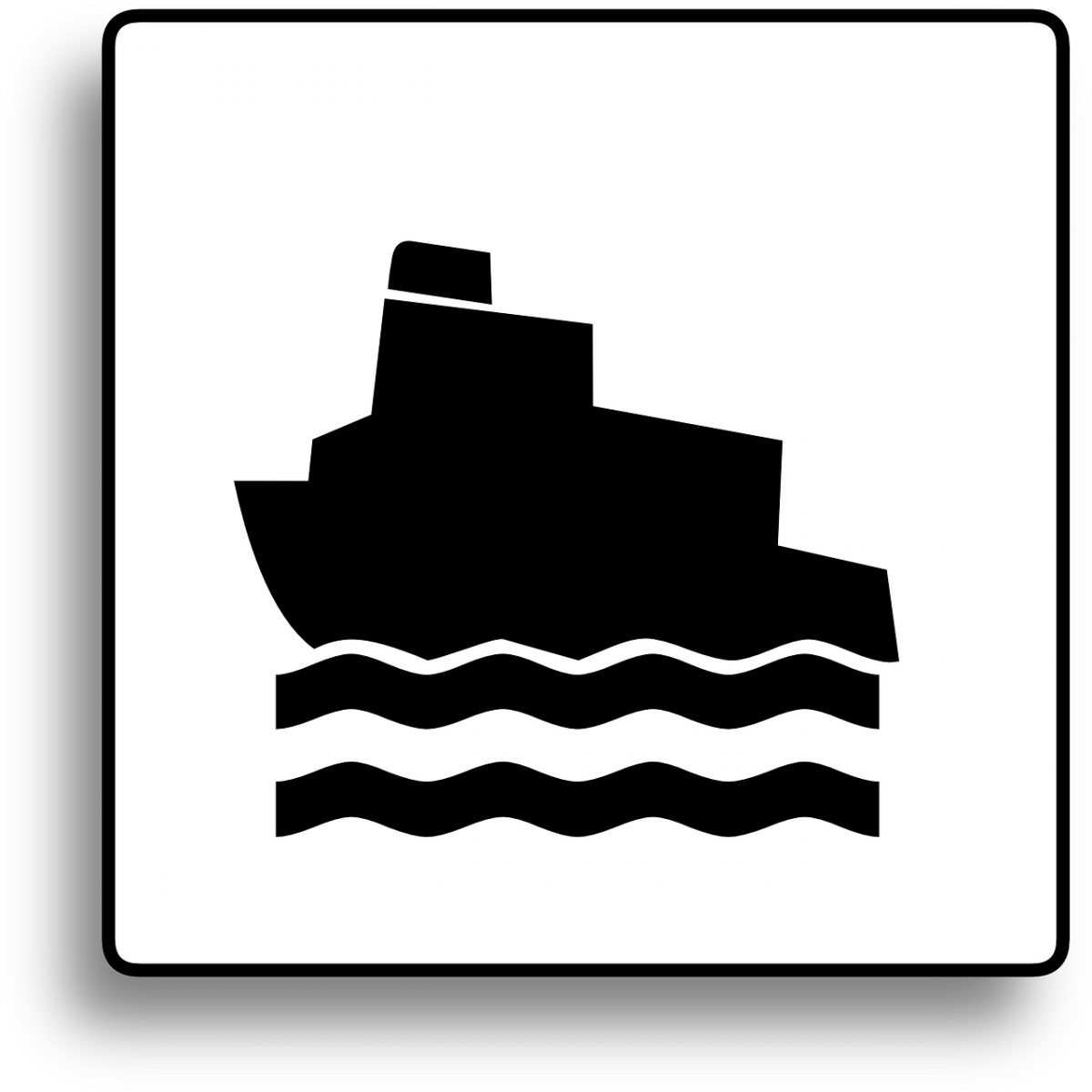
Road sign along the route of the Tar Sands Healing Walk, Treaty 6 Territory, Alberta, 2014. (Photo: Eugene Kung)
Over the past two weeks, the Federal Court of Appeal (FCA) panel of Justices De Montigny, Dawson and Woods heard oral arguments on the 15 consolidated challenges to the federal approvals of the Kinder Morgan Trans Mountain pipeline and tanker project. As we have written before, the case has the potential to overturn the NEB or federal Cabinet decisions.
West Coast attended almost all of the hearing. What follows is a summary of our highlights from the hearing – it is not meant to be a transcript, and most of the remarks are paraphrased.
 No Photos Allowed
No Photos Allowed
Since the Federal Court does not permit photography in the court rooms, we will be resorting to another form of visual aid for this blog: road signs.
ARGUMENTS OF APPLICANTS CHALLENGING THE APPROVALS
Elin Sigurdson, counsel for Upper Nicola Band, kicked off the hearing with an overview of the applicant’s arguments and a roadmap of the days ahead:
The Kinder Morgan Project risks destruction of ecosystems and harm to the environment, threatens endangered species, endangers human health, and threatens the Aboriginal rights, title and reserve interests of numerous First Nations.
Given those features, and given those risks, approval of this project by the Canadian Government should have been subject to strenuous and careful scrutiny.
Instead, as you will hear from the Applicants, the process for approval of the Project, which resulted in the decisions before this Court, was legally deficient in numerous ways.
Those legal deficiencies largely fell within two categories:
- Aboriginal rights and the duty to consult; and
- Statutory issues and procedural fairness
Sigurdson summarized her opening remarks by stating:
The applications before you challenge the National Energy Board’s report and the Governor in Council’s (GIC) order that recommend and permit the Project to proceed. The GIC’s order is ultimately one that is to be made on the basis of polycentric concerns giving rise to a public interest determination.
But these applications do not challenge the polycentric decision-making process; they raise issues upstream of the question of the public interest. Those upstream issues are constitutional duties, statutory obligations, and procedural fairness.
In short, these applications ask this Court to discharge its central obligation on judicial review, which is the protection of the rule of law.
To the extent that the applications before you attack the public interest determination by the GIC, this is a consequence of their principal arguments: a decision by the government that is not procedurally fair, that contravenes legislative requirements, and that is contrary to the honour of the Crown and its constitutional duty to advance reconciliation with Indigenous peoples – is not in the public interest.
INDIGENOUS APPLICANTS

As we have written before, each of the six First Nations applicants in this case independently hold inherent and constitutionally protected rights. Questions about these rights, their infringement, and whether the consultation process was adequate are determined on a case-by-case basis specific to each Nation’s facts and circumstances. In other words, a finding that the duty to consult was satisfied for one nation would not guarantee the same finding for another.
Following the submissions by the Indigenous applicants (set out below), the lawyer for Squamish Nation, Matthew Kirchner, summarized some of the common themes:
Consultation was A ONE-WAY STREET: Each Indigenous applicant encountered a Crown consultation team that was not there to engage in a two-way dialogue that was required and promised. Rather the Crown consultation team could only take notes and pass them along to Cabinet.
It is telling that not a single NEB condition was changed or added following phase three [of consultation - the consultation process that followed the NEB recommendation]. That is indicative of the Crown not being prepared to engage if it was to accommodate with an open mind.
Kirchner noted that Canada had “ample opportunity” to implement lessons learned from Gitxaala Nation v. Canada (the case that derailed the Northern Gateway pipeline project). However, while the federal government extended the process for Kinder Morgan, without meaningful engagement that extended process still didn’t meet the standard articulated in that case and others.
Addressing the importance of Cabinet’s engagement in the process, Kirchner stated:
The largeness of the project also means that the effects are large. The Crown should take the time and effort to do the studies. If these projects are such a national interest, then Cabinet should engage more senior staff to engage and make a decision.
Reconciliation is rarely achieved in the courtroom, but often times a decision is needed or sometimes more than one.
Returning to Sigurdson’s opening remarks:
The one-way street process provided by Canada here repeated the fatal errors articulated by this Court in Gitxaala. The Crown failed to meaningfully consult in relation to title, governance rights and use rights. Instead it dodged, deferred, delegated and in doing so fundamentally undermined the relationship the process of consultation is meant to foster and improve.
At the end of the day, the process Canada designed required the Indigenous applicants to participate, trusting that Canada would, this time, hear their concerns and address them head on. Instead, it was another empty opportunity to blow off steam that cannot stand in for real consultation, real relationship-building, and a real effort to address the collision between industrial development and Aboriginal rights.
Following the opening remarks, each nation made submissions about their specific rights and interests affected by the pipeline, the legal errors affecting the decision, and their specific experiences of consultation.
 Tsleil-Waututh Nation argued that marine shipping was unlawfully excluded from the designated project required to be assessed under the Canadian Environmental Assessment Act 2012 (CEAA 2012). Tsleil-Waututh also argued that Canada breached its duty to consult in three ways, including by implementing a unilaterally-designed consultation process that failed to meet minimum requirements of deep consultation, and that was indistinguishable from the lower-end consultation that this Court held was unacceptable in Gitxaala.
Tsleil-Waututh Nation argued that marine shipping was unlawfully excluded from the designated project required to be assessed under the Canadian Environmental Assessment Act 2012 (CEAA 2012). Tsleil-Waututh also argued that Canada breached its duty to consult in three ways, including by implementing a unilaterally-designed consultation process that failed to meet minimum requirements of deep consultation, and that was indistinguishable from the lower-end consultation that this Court held was unacceptable in Gitxaala.
During the oral argument, Tsleil-Waututh’s lawyer Scott Smith highlighted the fact that while consultation was underway, the Government of Canada was already preparing a website to announce the approval of the project – with no alternate version of that website. This suggested that the consultation was not meaningful, as the government appeared to have already made its decision on the project.
 Coldwater Indian Band argued that the effects of the project on its reserve aquifer (which is the sole source of drinking water for 90% of its residents) were never assessed or understood. Lawyers explained that this threat to the very livelihood of the members of the Coldwater Band caused the duty to consult to be breached, and constituted a breach of the Crown’s fiduciary obligation the Band in relation to the band’s established reserve interest.
Coldwater Indian Band argued that the effects of the project on its reserve aquifer (which is the sole source of drinking water for 90% of its residents) were never assessed or understood. Lawyers explained that this threat to the very livelihood of the members of the Coldwater Band caused the duty to consult to be breached, and constituted a breach of the Crown’s fiduciary obligation the Band in relation to the band’s established reserve interest.
Coldwater had just won a case in the FCA about the Crown’s fiduciary obligation with respect to the original Trans Mountain pipeline (constructed through Coldwater territory in 1952). Coldwater argued that the failure to consider the ‘west-alternative’ to the new pipeline route was an error of both the NEB and Cabinet.
 Upper Nicola Band argued that the Crown did not follow through on its promise to engage during Phase III of the consultation process and address concerns about impacts on their rights. In failing to grapple with the rights at stake for Upper Nicola and to understand project impacts on them in any meaningful way – and by never responsively or meaningfully accommodating their concerns – Canada’s consultation was, at best, superficial and was not honourable. In other words, it was a bumpy road.
Upper Nicola Band argued that the Crown did not follow through on its promise to engage during Phase III of the consultation process and address concerns about impacts on their rights. In failing to grapple with the rights at stake for Upper Nicola and to understand project impacts on them in any meaningful way – and by never responsively or meaningfully accommodating their concerns – Canada’s consultation was, at best, superficial and was not honourable. In other words, it was a bumpy road.
Upper Nicola’s counsel Crystal Reeves discussed Indigenous laws, noting that a source of those laws was in the land and the water. As a result, the Kinder Morgan Project not only had significant environmental impacts, but also impacted the sources of Indigenous laws, and therefore Indigenous governance as an Aboriginal right. The Crown approval did not recognize or consider the impact of its decision on these rights.
 Stk’emlupsemc Te Secwepemc Nation (SSN) told the court about the failure of the Crown to adequately consult about and address impacts from the project on SSN’s Aboriginal rights and title. In particular, they noted the government’s failure to engage with the Nation about the project’s proposed route, which passes through a sacred site at Pípsell and through sensitive grasslands in protected areas and previously undisturbed lands.
Stk’emlupsemc Te Secwepemc Nation (SSN) told the court about the failure of the Crown to adequately consult about and address impacts from the project on SSN’s Aboriginal rights and title. In particular, they noted the government’s failure to engage with the Nation about the project’s proposed route, which passes through a sacred site at Pípsell and through sensitive grasslands in protected areas and previously undisturbed lands.
The sacred site at Pípsell is also impacted by the Ajax Mine Project, which SSN has rejected under its Indigenous laws. Incredibly, Kinder Morgan has agreed to move the existing pipeline should the Ajax mine move forward, to allow for tailings ponds, while the company continues to refuse to address impacts on SSN’s rights and title.
 The Sto:lo applicants argued that the Crown failed to adequately consult regarding their established food, social and ceremonial fishing right, and never adequately responded to key information and issues that they’d repeatedly raised during the consultation process. The Sto:lo further said that the accommodation measures relied on by the Crown were wholly inadequate.
The Sto:lo applicants argued that the Crown failed to adequately consult regarding their established food, social and ceremonial fishing right, and never adequately responded to key information and issues that they’d repeatedly raised during the consultation process. The Sto:lo further said that the accommodation measures relied on by the Crown were wholly inadequate.
Sto:lo lawyer Jana McLean argued that if the approach to consultation for established rights was identical to that for asserted rights, then those established rights had little value. Sto:lo faced the same one-way street as the other Indigenous applicants, which Sto:lo argued did not meet the honour of the Crown. Even though the Crown accepted that the project would infringe these established rights, they never provided any justification for the decision to approve it.
 Squamish Nation argued that – despite the significant intrusion the project represents on Squamish’s people, lands, waters and resources, particularly by the marine terminal and increased vessel traffic traversing their territory – the Crown, through project conditions, deferred obtaining information that is essential to assessing impacts on Squamish. This information will not be available, if at all, until after the project is well underway and the time for assessing impacts and identifying measures to mitigate or accommodate is long past.
Squamish Nation argued that – despite the significant intrusion the project represents on Squamish’s people, lands, waters and resources, particularly by the marine terminal and increased vessel traffic traversing their territory – the Crown, through project conditions, deferred obtaining information that is essential to assessing impacts on Squamish. This information will not be available, if at all, until after the project is well underway and the time for assessing impacts and identifying measures to mitigate or accommodate is long past.
Squamish lawyer Matthew Kirchner argued that the Crown did not correctly assess Squamish’s strength of claim to lands and waters impacted by the pipeline, and failed to assess the impact of diluted bitumen on Squamish’s rights.
MUNICIPAL APPLICANTS
On the third and fourth days, the Court heard from the Cities of Burnaby and Vancouver, and from environmental organizations.
 The City of Burnaby argued that the process followed by the NEB was unreasonable and did not produce a valid report in compliance with CEAA 2012 and the NEB Act, and, as a result, the Cabinet decision (which was based on the NEB’s process) cannot stand. The NEB failed to consider alternative locations for the marine terminal and failed to consider certain risks and effects of the project, and it deferred the collection of evidence on those risks and effects until after the Cabinet decision had been made. The failures of the NEB were compounded by procedural errors – including the refusal to allow the testing of evidence through cross-examination, the refusal to direct Trans Mountain to address missing evidence before the Board, and the failure to give adequate reasons for its decision in its report.
The City of Burnaby argued that the process followed by the NEB was unreasonable and did not produce a valid report in compliance with CEAA 2012 and the NEB Act, and, as a result, the Cabinet decision (which was based on the NEB’s process) cannot stand. The NEB failed to consider alternative locations for the marine terminal and failed to consider certain risks and effects of the project, and it deferred the collection of evidence on those risks and effects until after the Cabinet decision had been made. The failures of the NEB were compounded by procedural errors – including the refusal to allow the testing of evidence through cross-examination, the refusal to direct Trans Mountain to address missing evidence before the Board, and the failure to give adequate reasons for its decision in its report.
City of Burnaby lawyer Greg McDade argued that putting a pipeline through a densely populated (and rapidly growing) urban area, and then BEHIND one of the world’s busiest ports was, in fact, the worst alternative, not the best.
The City of Vancouver argued that the NEB did not meet its statutory requirements under CEAA 2012 by failing to include project-related marine activities in its review, failing to properly assess the effects of greenhouse gas emissions and failing to perform a proper spills assessment. Vancouver argued that the NEB failed to consider relevant evidence in its public interest assessment, and consequently failed to properly perform its obligations under the National Energy Board Act. Vancouver also argued that the NEB committed errors of procedural fairness that fundamentally undermined the process.
ENVIRONMENTAL ORGANIZATIONS
 Raincoast Conservation Foundation and Living Oceans Society argued that the NEB and Cabinet failed to comply with the statutory requirements of the Species at Risk Act (SARA) with respect to the significant adverse effects of the Project on southern resident killer whales and their critical habitat.
Raincoast Conservation Foundation and Living Oceans Society argued that the NEB and Cabinet failed to comply with the statutory requirements of the Species at Risk Act (SARA) with respect to the significant adverse effects of the Project on southern resident killer whales and their critical habitat.
Building on Tsleil-Waututh’s argument about marine shipping, Raincoast and Living Oceans’ lawyer Margot Venton argued that excluding marine shipping from the environmental assessment allowed the NEB to bypass mitigation measures required under SARA. This was a legal error. Raincoast and Living Oceans also argued that the federal government’s new Ocean Protection Plan was no substitute for SARA, and was not enough to deal with the risk to whales posed by Kinder Morgan’s Project.
 BRITISH COLUMBIA
BRITISH COLUMBIA
British Columbia’s argument as an intervenor focused on a narrow issue: that the Cabinet’s reasons to approve the project, set out in an Order in Council, did not meet the legal and statutory requirements for adequate reasons. Instead, they just stated their conclusions, without explanation. In short, the Order in Council bypassed the legal requirements for adequate reasons: which require more than just stating conclusions, but rather, the reasoning behind those conclusions.
ARGUMENTS OF RESPONDENTS DEFENDING THE APPROVALS
 Kinder Morgan Trans Mountain was the first respondent to present, starting on day 4 (Thursday, October 9) and ending on day 5 (Tuesday, October 10). Interestingly, Kinder Morgan’s lawyer Maureen Killoran announced that she would not focus on legal arguments, but rather would review the steps that the NEB and Cabinet took in the approval to demonstrate that it was robust, and that the concerns raised by opponents were considered and dealt with. In particular, Kinder Morgan argued that its alternatives were limited to what was economically viable, in the context of the existing pipeline and right of way. Essentially, Kinder Morgan’s argument boiled down to this: the process of approval by the NEB and Cabinet was robust, and the court should not allow for a U-turn.
Kinder Morgan Trans Mountain was the first respondent to present, starting on day 4 (Thursday, October 9) and ending on day 5 (Tuesday, October 10). Interestingly, Kinder Morgan’s lawyer Maureen Killoran announced that she would not focus on legal arguments, but rather would review the steps that the NEB and Cabinet took in the approval to demonstrate that it was robust, and that the concerns raised by opponents were considered and dealt with. In particular, Kinder Morgan argued that its alternatives were limited to what was economically viable, in the context of the existing pipeline and right of way. Essentially, Kinder Morgan’s argument boiled down to this: the process of approval by the NEB and Cabinet was robust, and the court should not allow for a U-turn.
As one observer mentioned to me, it was like listening to the minutes of a very long public meeting being read. Not exactly Law & Order. However, the bench had a number of questions for Kinder Morgan about marine shipping and alternatives as raised by the applicants.
 CANADA
CANADA
Canada’s arguments on days 6 and 7 can be summarized as follows:
- The Order in Council decision was based on many documents, including the NEB report, and together these documents constituted sufficient reasons.
- Canada implemented the Gitxaala decision and improved its process based on that decision by considering Indigenous interests.
- The primary benefit of the project was access to tidewater (a myth we have busted previously).
- The NEB was reasonable to exclude marine shipping from the CEAA 2012 review of the project.
- Consultation with First Nations met the legal standard, and in particular, six factors highlighted in Gitxaala were not repeated in the Kinder Morgan review process.
- Canada worked very hard to advance reconciliation, develop trust, and move forward as partners with affected Indigenous nations.
Ultimately, Canada’s argument was that the federal Cabinet decision weighed a number of factors, including Indigenous rights, economics, and environmental impacts. The federal government’s lawyers argued that Canada made a balanced polycentric decision (a decision that considers a number of interacting interests and considerations) – and that the courts must yield to that decision.
 ALBERTA
ALBERTA
The Attorney General of Alberta’s oral submissions were short and sweet – less than five minutes! Lawyer Doreen Muller thanked the court for the careful attention paid to the arguments made, and echoed Canada’s call for a polycentric analysis while stating that there was enough evidence before the court to uphold the decisions.
 NEB
NEB
The National Energy Board’s argument focused on the ongoing route hearings and enforcement and monitoring of conditions. In essence, the NEB said: “Our work is not done, and we could fix any problems in the future.”
CONCLUSION
The legal challenges to the Kinder Morgan Trans Mountain Pipeline approvals had international attention for good reason. The case encapsulates some of the most important themes of our time: climate change, Indigenous rights, the nature of Canadian federalism, and the influence of the oil industry on our democratic institutions, to name a few.
However, the Court will decide this case on the legal merits and the record before it. In my opinion, it boils down to two key questions:
- Was consultation with First Nations meaningful and adequate, following the Gitxaala decision and leading cases from the Supreme Court of Canada?
- Does the fact that Cabinet made a polycentric decision mean that the Court can’t take a hard look “behind” (or “upstream of”) the decision to see if constitutional & statutory duties were properly met before balancing the interests? Or does the Crown first have to discharge its constitutional duties and statutory requirements before balancing interests?
These question may ultimately end up before the Supreme Court of Canada, whichever way the FCA decides.
The Supreme Court stated in its recent Clyde River decision: “A project authorization that breaches the constitutionally protected rights of Indigenous peoples cannot serve the public interest.”
It is not certain when the FCA will release its decision. In Gitxaala, a similar case, it took about eight months after the hearing. The court has indicated that a faster decision is in the public interest, so we can probably expect something in the next two to six months.
In the meantime, the legal challenge to the BC provincial approval of Trans Mountain is scheduled to be heard in early November, so we will see Kinder Morgan in court again before long.